A Skier Discovers the Best Way To Explore British Columbia’s Secret Stashes
This article originally appeared on Ski Mag
"So, we're having a hard time reaching anyone at any of these resorts."
I laugh as Rick, our travel planner, is despairing over the unreachability of an actual human at the tiny resorts we're planning to visit. As we dissect our itinerary via Zoom, Rick's concern about the lack of officially supported RV camping is evident. We'd need space each night to park the supersized Canadream Motorhome we'd commandeered for the trip.
"It'll be fine," I reassured him, "we'll just ask the locals where we can park up." I had to chuckle at his good-natured organization. These plucky communities have survived on logging and mining in some of the most remote regions of B.C. Due to their intense weather systems, many didn't have cell service or reliable internet access, so responding to emails from unfamiliar journalists probably wasn't high on their priority lists. We had switched our Google search from 'ski resort' to 'ski hill,' allowing a few red pins to sprout up in a vague northerly route. The rationale for picking our destinations was essentially this: the less information we could garner, the better. My main goal was to skip the inefficiencies of a traditional ski trip. No more dragging duffel bags through hotel lobbies and frenzied driving to the parking lots each morning to secure a space.
Sleeping next to the lifts themselves seemed like a great idea--my only hesitations were surrounding humidity and came from years of living in a 1982 camper van in my youth. After a quick peruse of the internet, I found the ideal solution. Canadream offered a fully-winterized, 28-feet-long, 6.8-litre Ford E450 Super Duty RV that was built to be fully self-sufficient, boasting heating, a toilet, hot shower, stove, fridge, and power sockets for our phones (and more importantly, my heated socks). For most people, road trips are in summertime, associated with the windows down, hair flowing in the breeze, parking the van in a new spot every night – preferably by a body of water. This was going to be a little different. After a few back-and-forth emails, it was decided. The colossal – and relatively luxurious – vehicle we chose would take us on our 3,000-kilometer journey, crossing ill-reputed mountain passes and stopping at five small ski resorts over seven days before doubling back via a 22-hour ferry to Vancouver Island, where we would ski one final resort.
As departure day loomed, a snowfall warning was declared for British Columbia, followed by an arctic outflow. We decided to keep the forecast to ourselves (no need to panic Rick any further) and double-checked that snow chains came with the rental. Our first leg, Vancouver to Mount Timothy, was a 7-hour drive and what you would call a baptism of fire. Snow fell relentlessly onto roads glazed with black ice, while gusts of wind risked blowing us right off the hard shoulder as flakes stuck to our windshield. We concluded by overshooting the turnoff by 20 kilometers and doubling back, squinting through the blizzard to spot the tiny resort sign. Finally, we collapsed into our luxurious queen-sized bed much later than we'd hoped, but we were safe, comfortable, and definitely warm.
It snowed just 7 centimeters overnight, but with the resort being closed Monday through Wednesday, there was a 72-hour buildup of fresh snow for us to enjoy Thursday morning. We were swiftly introduced to Larry, the owner, whose oil-stained hands, cheeky grin, and quick wit made him seem young for his years. Aside from running the resort as a 'retirement project,' he was also partial to snowmobiling and gold mining. Lori, Larry's wife, and Lianna, the resort manager, ushered us in and immediately brewed a fresh pot of coffee for us in their warming cabin. It was cold and only going to get colder.
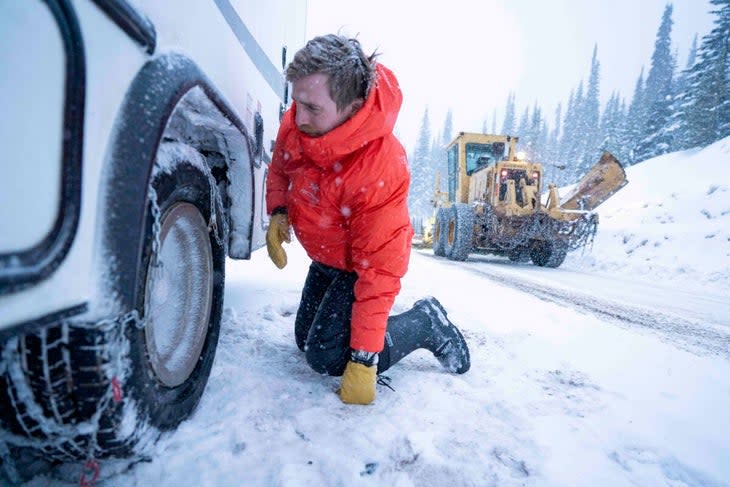
We spent the day skiing with volunteer patroller Ken, who showed us his private collection of powder stashes serviced by just one Coca-Cola red chairlift: Triple Chair. The terrain wasn't steep, but the snow was dry, airy, and abundant. A forester by day, Ken has been a Mount Timothy local for 24 years. He told us of Larry's planned expansion to add a new chairlift and plans for a winter bike park with a patent-pending Doppelmeyer lift attachment for bike handlebars. We became fast friends and--with full bellies and satisfied souls--resignedly said our "goodbyes," "thank yous," and "we'll be backs," which would become a bittersweet routine on our trip. Just as we left, Lori snuck her Mom's homemade carrot cake into our hands with a wink and wished us safe travels. Its distance from any major airport will likely keep Timothy a hidden gem for years to come, and we drove away excited in the knowledge the resort has an innovative future.
That night, after a much shorter drive of three and a half hours, we pulled into a fresh foot of snow in the lot of our second stop: Troll Resort. "Just don't stop until we're in a good spot," I began to say right as my partner skidded to a halt, wheels akimbo, beaching us in just about the worst location possible. Within two minutes, a bobbing headlamp accompanied by the rhythmic crunch of boots on snow approached in the darkness. "Hello, welcome!" – a kind voice snapped Ben and I out of our bickering in the front seat. It was Hildur Sinclair, owner and operator of Troll Resort, who we later found out has an esteemed reputation for football-sized cinnamon buns. She hugged us warmly and told us to settle in, relax, and come and find her in the lodge kitchen in the morning. She didn't need to tell us twice--legs cooked and eyes sore from another white-knuckle drive. We were asleep in seconds.
When daylight came, I extracted myself from my warm cocoon to discover that our enormous RV was obnoxiously marooned on a snow island in the middle of Troll's modest parking lot. Just ahead, a sprawling single-story log cabin with a lightly smoking chimney beckoned us in. We'd need help freeing the RV anyway. The lodge was empty save for a couple of kitchen staff, a sunken concrete hearth, and an impressive taxidermy display on the overhanging beams. Leonard--Hildur's husband--informed us that Hildur's father hand-built the cabin, and the kitchen crew was there early to prepare food for the local miners. "Breakfast?" one of the cooks called out. We weren't sure if it was an offer or an instruction, but we were swiftly presented with a heaping plate of toast, bacon, and eggs.
As we stalled in the warmth while sipping coffee, the lodge filled up with members of the local community, all familiar to one another. We were directed to our guide for the day--local legend Steven Kaufman--who was waiting at the base of the T-Bar. To my surprise (and my one-planking boyfriend's dismay), we learned this was the second-longest T-Bar in North America, shy of the longest by just 6 meters. Laughing, Hildur tells us, "Steve always has to be first on the T-Bar, even though there's never a line." Steve took us on a spectacular tour de Troll, where we enjoyed fresh tracks on every run, each of which fed us back to the warm and welcoming lodge--a huge advantage when temperatures have you flirting with frostbite. We had a mid-morning stop at his on-mountain cabin, where his family was in the trenches cooking a belated Christmas dinner. He tells us that he originally bought the lot for $25,000 and built the structure from the ground up. Ben and I stole a glance at each other--this cabin, with its gleaming logs, capacity to sleep twenty, and immaculate hygge-would be worth tens of millions in our town. We enjoyed a frosty 10:30 a.m. beer by the log burner, discussing a potential party at Steve's cabin for next New Year's. Steve is in charge of the annual unofficial fireworks display, and we can imagine it's something to behold.
Troll is the perfect candidate for resort expansion--and their plans to develop neighboring Pinecrest Mountain attest to this. Just two hours south of Prince George, Troll feels rural, quaint, and agricultural, just a stone's throw from some of the province's major corn farms and historic gold towns. With Hildur at the helm and her army of women running the bustling kitchen, it felt like coming home for the holidays. There were more Norwegian sweaters on show than Goretex jackets and some of the ski boots and snowmobiles looked like they belonged in a historical museum. After a helping hand from a roaming JCB, we were freed from the confines of our snow island and sent on our way with stuffed bellies and goofy grins that wouldn't budge.
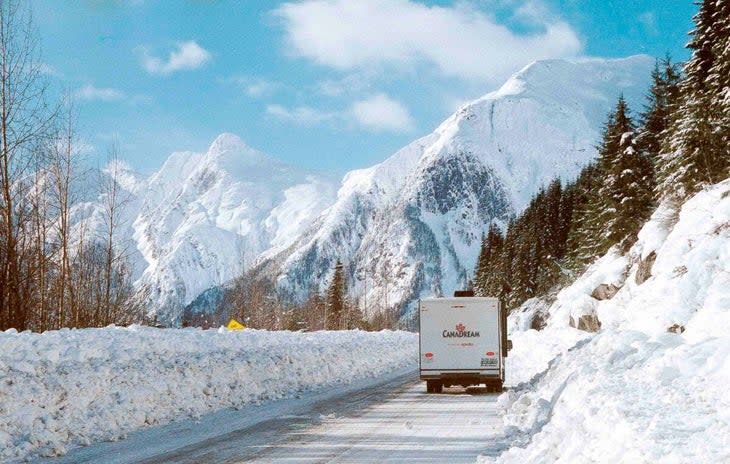
Perched just off Hwy 97, Powder King is situated two hours on the other side of Prince George. It is the other logical ski option for residents of the industrial hub, and the contrast between Powder King and Troll is stark. This no-frills ski hill would be our northernmost point, where the Alaska Highway slices through the northern Rockies. Due to the aforementioned snowfall warning, the usual 4-hour drive to 'PK' through the infamous Pine Pass took us an unhurried 7. It was capped off by a 45-minute chain up on the side of the highway, made particularly painful by the knowledge that our camp spot was a mere 900 meters away. Semi-trucks thundered past us in the orange-white glow until, eventually, we were ready to ascend.
Our slumber was cut short by a horn so loud we feared we'd parked on a train line. Bleary-eyed and still in the fog of sleep, Ben opened the side door--wearing only his underpants-- to placate the displeased plow driver. A small and mildly terrifying woman, we could barely hear what she said over the machine's engine and the howling wind. After exchanging confused yells, we understood that she wanted us to move to another, more vagabond-friendly parking lot. We scraped a foot of snow off the windshield and complied before returning to sleep.
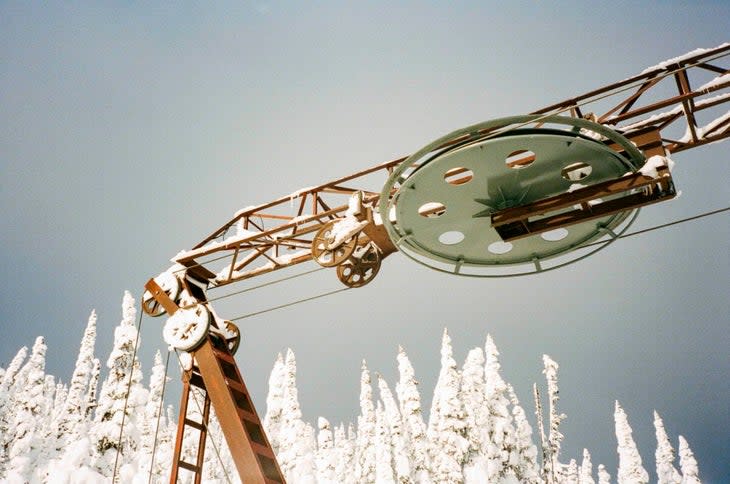
After a few hours, daylight came, and we headed into the base area. The charming log cabin aesthetic that had become familiar was replaced with functional, no-nonsense buildings. Employees were identified by their greased Carhartts and seemingly superhuman resistance to the cold. Gargantuan trucks sporting oversized tires and snowmobiles with MacGyvered ski carry systems filtered slowly into the lots. A plain white sign with "ski school meet here" was the only sign of commercial activity.
What it lacked in alpine aesthetic, Powder King made up for in snowfall. Powder King had received 2.5 meters of snow in the first 17 days of February alone, and it felt like half of it had fallen on our drive the night before. Like the other resorts, it was open only from Thursday to Monday, allowing foot upon foot of snow to accumulate before the weekend. It had the largest vertical gain of all the resorts we would visit-- 640 meters. A short traverse past the boundary fence revealed playful gladed tree areas that boasted flowing natural terrain features. We became fast friends with a zone called 'The Elevator Shaft'. Refreshingly vertical, we skied just a few trees over from each previous run and scored fresh turns every time, even without a guide.
We learned that in recent years, the 60-cabin village at the base has experienced a real estate buzz, and the resort has garnered increasing media coverage by hosting professional athletes. Combined with its unmatched snow quality and excellent terrain, Powder King could be on the brink of a quantum leap from a whisper on the lips of Northerners to a rock-star ski resort. After the last upload at 3:15--a full-blown pow run--we slumped into a booth at the raucous, bare-bones PK Bar. Flushed and content from the day's skiing, we were swiftly defeated by the Avalanche Platter--a callosal mass of fried beige. Packed to the rafters, locals were still arriving late into the night, many having driven from 'town'--a 70km snowmobile ride. Thankfully, we only had to make it 70ft back to our quarters.
After enjoying a second bluebird powder morning, Ullr granted us mercy and graced us with a weather window to schlep 600 kilometers across the province to Hudson Bay. This would be our longest stint by far. Finally, my Audible subscription was getting its dues. With just one stop for gas and convincing a bemused campsite owner to let us dig out (and then use) their water disposal system, we made it in 8 hours. We pulled into Smithers fifteen minutes before the brewery's advertised closing time, arranged a handshake deal with the bartenders to sleep in the parking lot, and sampled some delicious IPAs before bed. We awoke to a dusting of snow, which turned into a full snowstorm by the time we showered and dressed. Racing to get going before we needed chains (the roads were in great shape, but for how long?), we headed up the 22-kilometer road that gained almost 1000 meters of elevation.
Once we reached the top (spoiler: we did need chains), it snowed 5 inches in the first two hours, and the deluge of fat flakes did not cease. No less than 72 boutique cabins speckled the mountain, but they eluded us in the storm. We gorged on pow until our legs were jelly, fist-bumping down each thigh-deep run. Ideally, warming huts across the mountain saved our frozen fingers and were the perfect spot for a mid-mountain pick-me-up. Hut breaks were also the only times we spotted other humans, and for the most part, we skied what felt like an empty resort. Cars parked in the morning were invisible against the snowbanks by the end of the day; we could only identify ours due to its sheer volume. Days this deep and uncrowded must be blissfully commonplace for those who live and ski at Hudson Bay. With disbelief approaching frustration, we added the resort to the ever-growing 'must return to' list and set off into the night. It was still dumping.
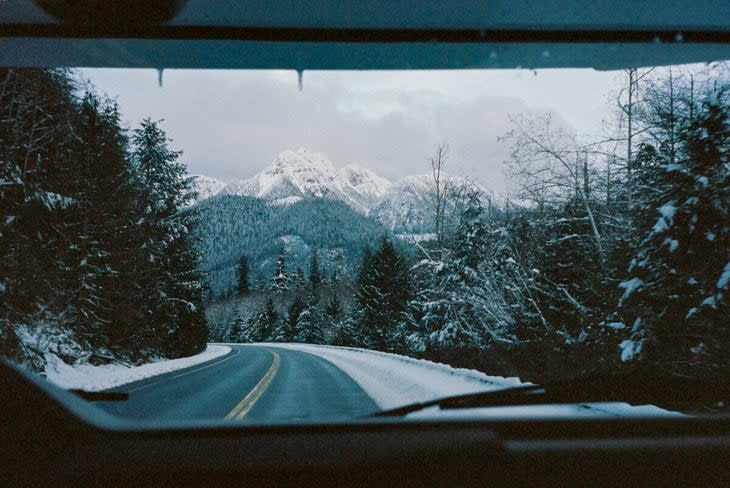
Giant waterfalls that have frozen mid-cascade embellish the Shames Mountain Road. Ice-blue and intimidatingly beautiful, they hang from the vertical rock walls that tower above the road, giving the impression that you are passing through a portal to another world. This was not too far from the truth. Arriving at Shames felt like we'd stumbled upon Disneyland for backcountry skiers, minus the punters. Shames--the first nonprofit ski co-op in Canada--boasts an average annual snowfall of 12 meters (more than Whistler or any other lift-accessed area in Canada). True to form, it had a remote location, a winding access road with eye-melting vistas, and a humble 487 meters of vertical. We arrived to pristine blue skies and snow banks that dwarfed our 28-foot RV. The pile of technical backpacks atop the T-Bar was a dead giveaway that the locals couldn't resist a warm-up lap (and neither could we). The resort's front side offered a mix of perfect corduroy and steep blacks with intriguing names such as Terminator, Hangover, and Deliverance.
A hop, skip, and jump from the T-Bar took us into some of the most mind-blowing terrain south of Alaska. My eyes feasted on peak after peak of side-lit spines that seemed straight out of the opening credits of a ski movie. Due to the heavy recent snowfall and being strangers to the area, we skied low-angle terrain, which paid surprisingly generous dividends. On a bluebird pow Saturday, we saw no more than twenty people in the backcountry, and each one stopped to say "hi." I kept looking around in disbelief: "Where is everyone?". It was unbelievably refreshing.
Shames's total tenure is more than 3,000 hectares or 30 square kilometers. Our home resort, Whistler Blackcomb, has 3307 hectares. That's close enough to just 10% less. Imagine skiing Whistler Blackcomb (minus one lift's worth of terrain) without any lifts or crowds. Its laid-back vibe, combined with the fact there's only one way up, led to an exquisitely simple routine. Ride up the chair (fixed-grip, of course), skin for an hour, and ski bottomless fresh powder back to the base. Repeat. You'll find no mountain-top oysters or champagne showers here, but for those who prefer their inbound lines non-existent and backcountry lines beyond fathom, you'll never want to leave Shames.
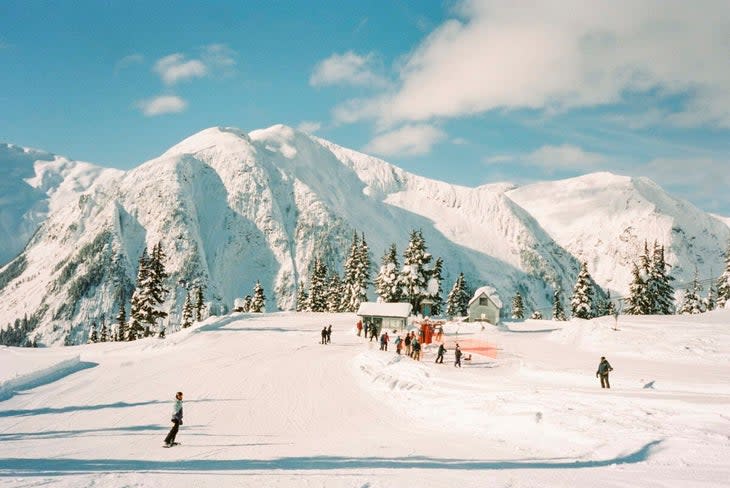
We boarded the Northern Expedition in another snowstorm as we began our 22-hour, 500-kilometer cruise back south. Supposedly, the Inside Passage is renowned for its incredible views. We left at 11 am and arrived at 9 am the following day, relatively well rested but sporting a slight wine hangover (our card deck got a hammering). The lady on the tannoy informed us as we prepared to disembark that the road had not been plowed and to take extra caution. This much snowfall was wildly unusual for the temperate rainforest of Vancouver Island. I had sent Mount Cain numerous messages about whether or not it was a reckless idea to drive our RV up their steep access road. The response I repeatedly received was, "it's been done before..." which did nothing to quell my anxiety or aid our decision-making. We chained up early, headed into the storm, and figured we'd try. Two feet of fresh snow sat atop the endless switchbacks, but with a decent run-up, creative handling, and low gear, we got there without compromising our damage deposit. The looks of disbelief as we cruised into the upper lot had us patting the hood and whispering our gratitude to our behemoth.
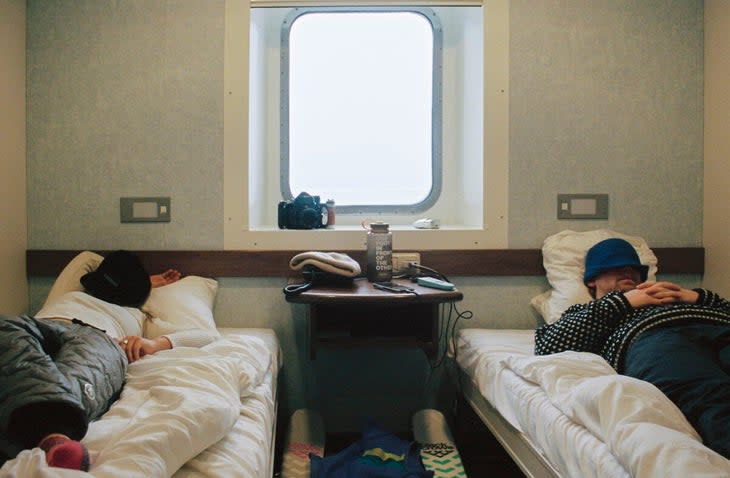
A full-day lift ticket at Mount Cain costs $42 USD. My eyeballs almost popped out of my head. I remembered reading that one resort in the USA was reportedly charging over $300 USD for a day ticket this year. Then again, Mount Cain shares almost nothing with typical ski resorts. The parking lot is a disheveled community of dogs, vintage campers, and tents. With limited accommodation at Cain, the resort encourages creative sleeping solutions al fresco, allowing for a vibrant dirtbag subculture. Our outside accommodation had to be the best of the bunch and was perhaps even more luxurious than some indoor options. With almost 500 vertical meters of steep and challenging inbounds terrain, including some excellent tree-skiing, Mount Cain punches above its weight for both quality and quantity of skiing. We had heard the backcountry here was world-class, but with zero visibility and reports of a large slide the day before, we decided to stay inside the resort boundary --and we weren't disappointed.
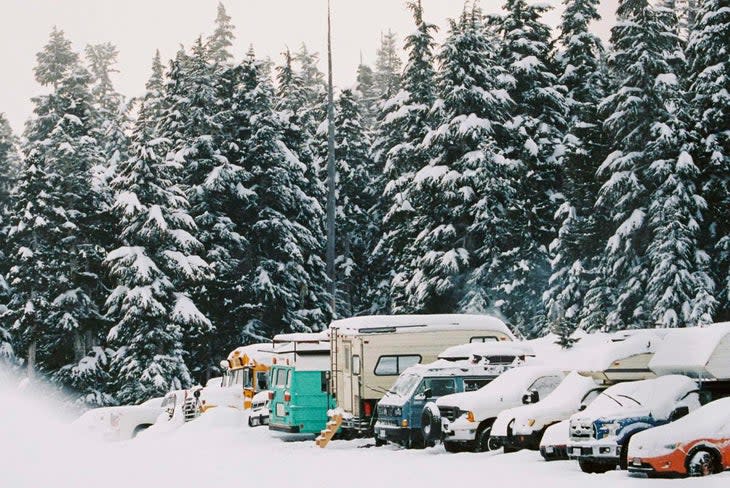
In the skier's cabin--about a fifth of the size of any we'd seen thus far--Mount Cain somehow squeezed in a rental shop, gift store, hostel, kitchen, and 'Turk's Tavern,' which straddled the line between a rustic-chic Austrian chalet and rowdy dive bar. A simmering post-skiing ambiance was made of local chatter about kids' hockey nights, potluck dinners, and snowmobiles. The night descended into enthused yelling about whose Tacoma was blocking whose songs we didn't know, and bickering over whose turn it was to buy a shot ski. We discovered the table next to us--undeniably the life of the party--was half made up of board members and volunteers of Mount Cain for over 25 years. Most came up to Cain every weekend with their families and had created a skier's haven that seemed almost rebellious in its simplicity. You can't help but be fully engrossed in the experience; with no cell reception or wifi, you feel entirely isolated from the rest of the world. It seemed that Mount Cain was not on a development trajectory and had little, if any, desire to be 'on the map.' Locals and visitors rejoiced in its modesty, and the feeling was mutual.
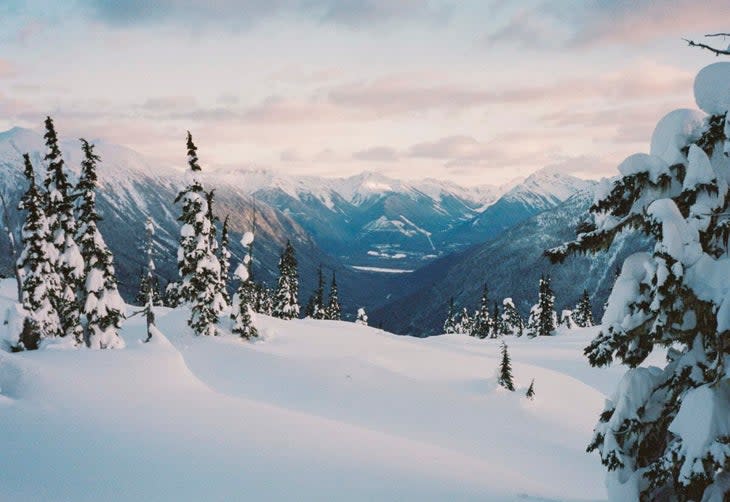
Part of the magic of these resorts was that, due to limited upload capacity, the terrain couldn’t get fully tracked out on a powder day. Getting to know the locals isn't optional, thanks to the lengthy ritual of the T-Bars. In the rare instance of a line-up (usually caused only by a temporary lift malfunction), solo skiers skimmed the lines, calling out "single?" until they found a partner in a routine that fosters efficiency and camaraderie. What these resorts lacked in vertical meters and modern trimmings, they made up for in snow quantity and quality. Usually, we're posed with a choice between one or the other. The free-spirited essence of the sport--skiing just for the simple joy of it--is alive and well in these home-grown, hardworking, and, for the most part, bare-bones ski areas. We were welcomed with open arms by communities whose passionate volunteers were the lifeblood of the operation. This feels like a much-needed correction in an era when the ski industry is seemingly obsessed with expansion, acquisition, and high-speed everything. As our new friend, Darren Anonson (professional faller and Director of Snow Machine Ops at Mount Cain) told us, "it's not about the skiing." Well, the skiing was pretty damn good too.
When You Go:
Nearest Airport: Vancouver International
Accommodation: Canadream RV's MHA Maxi Motorhome
Resorts: Mount Timothy, Troll Resort, Powder King, Hudson Bay, Shames Mountain, Mount Cain
For exclusive access to all of our fitness, gear, adventure, and travel stories, plus discounts on trips, events, and gear, sign up for Outside+ today.

